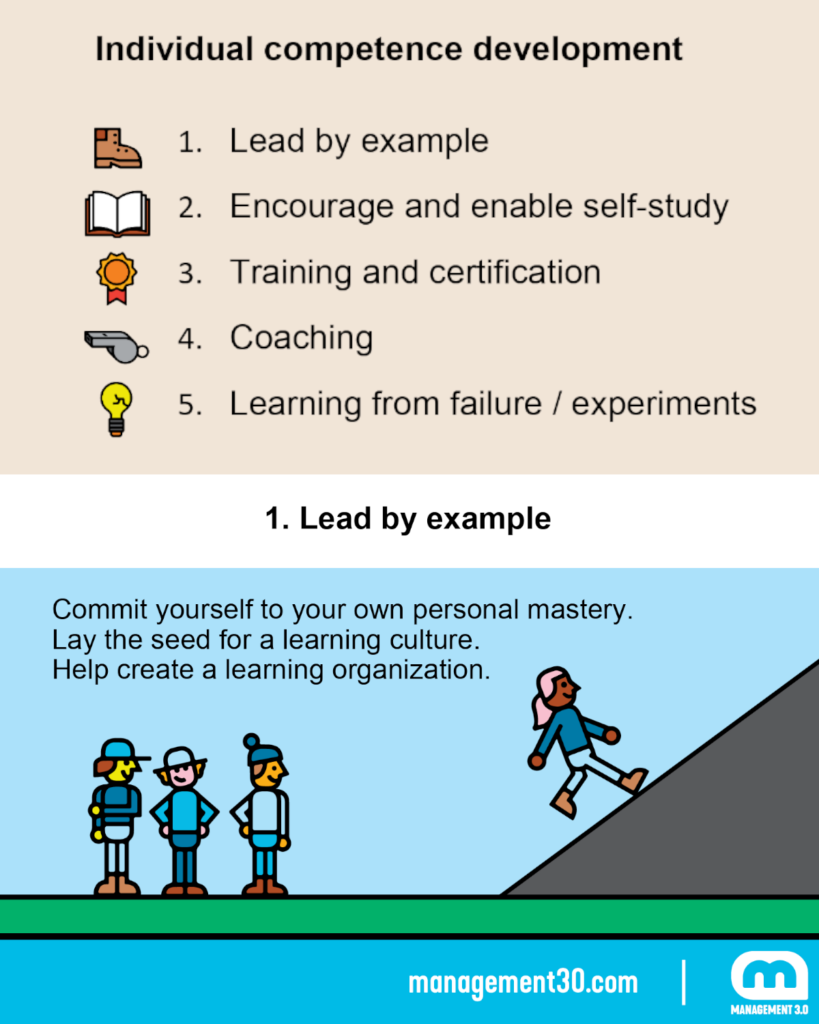Our whole life is full of moments that have impacted us, and some of them serve as inspiration for the actions we take day after day in our daily lives and also at work. This is an article about Leading by Example by Management 3.0 Facilitator Guillermo Lechuga from Mexico.
One of the biggest mistakes we can make as leaders: Asking for something we are not willing to give. For example, I want teams to be accountable and keep all of their commitments, but rarely as a leader have I kept my commitments to them.
Many times unconsciously we do not realize it, and we get frustrated because people “do not respond” or “do not change” and sometimes in response, we begin to have unfriendly behaviors, forcing what we are looking for to happen, many times through fear.
In some companies where the leaders are not very tolerant of error and punish it, there is a high probability that the people they led when they became leaders, will have similar behaviors, even though it made them feel bad.
Whether we like it or not, we are a sum of the experiences and styles of those who have shaped and influenced us. The challenge is to find our own identity as leaders understood as the sum of the contribution of others plus what you can add.

What does it mean to lead by example?
I remember that from a very young age when I found myself in leadership positions I began to use a phrase that I shared with my collaborators without having much knowledge of the subject: “Be the boss you would like to have.“
Today I would replace the word “boss” with “leader”, plus everything else I would keep. I remember being inspired by the phrase “Treat others how you would like to be treated.”
It is important that as leaders we reflect on the way our actions make people feel and how our behaviors leave an imprint on them positively or negatively, depending on how it impacts the person.
I must admit that there are leaders who I remember fondly and whose actions have impacted me and are part of my way of leading today, as well as others that I remember with great sorrow and who today I have realized how they made me feel, and hope they have changed for the good and that of others.
What happens if managers don’t lead by example?
I knew a leader who all the time complained about his peers and his leader, he always avoided reaching a valuable conversation with them and tried to generate a plot with others so he would come out ahead. Guess what happened? Later the same teams acquired their behaviors and complained about others but never tried to solve them. This generated a lot of stress for the leader and he did not realize that he was partly the influence of that behavior.
He got frustrated that teams weren’t behaving in a way that he didn’t.
It is something natural, it will always be much easier to seek to change others and blame them for the things that happen, instead of taking responsibility and starting the change by ourselves. Seeing yourself as a leader is an exercise in change and humility.
We cannot control how others think or act, but we can do it from our court, with ourselves. It is here, where through change, we can inspire others and drive change by being an example.
How is a leader by example characterized?
Something that I feel characterizes my way of leading, is my genuine concern for the well-being of people in addition to their professional and economic growth, whether within the company or outside of it. And you know, this was influenced by a great leader that I had at the beginning of my professional career, who advised me to take a job opportunity even though that created a big problem for him.
Read on: Servant Leaders enable success by enabling people to succeed. Servant Leadership – What is it?
Now I invite you to identify what positive behaviors your leadership has and if these have been influenced or inspired by other leaders. It is very likely that right now you are remembering a beautiful moment.
This is how we should make people feel! Through conscious, humane, and above all consistent leadership. Where one leads by example.

How to lead by example: An exercise
Surely, today you would like your team to have different behaviors. I’m going to cite some of the more common wishes that leaders have shared with me in recent years, along with some probing questions.
| What you wish your team to do | What you should ask yourself in terms of leading by example |
|---|---|
| Be responsible | How responsible are you with them, with your peers, and with your leader? |
| Give frequent, lateral, and horizontal feedback | How often do you give feedback to your peers? To your leader? To your team? |
| Know how to say “No” | Have they seen you say “No” to your boss? |
| Seek to constantly learn | How often are you learning something new? Do you share these learnings with them? |
| Get creative | How creative are you? |
| Let them discuss and seek to reach agreements | Do you argue with your peers/leaders or evade the fight? |
| That they are aware that the result is when the product is delivered and not when their part ends | Do you apply this with the entire organization? |
| Always seek to do the best | How much every day do you apply continuous improvement? |
So, I invite you to make a list with the following format, in the order of the columns:
| What behaviors would I like my team to have? | From 1 to 10, how often do I consider how frequent I have this behavior? | How do I encourage this to happen in the team? | What can I do to change it for myself? |
|---|---|---|---|
| Be responsible | … | … | … |
| Give frequent, lateral, and horizontal feedback | … | … | … |
The idea of this exercise is that you stop waiting for others to change and start driving that change from within yourself.
Read on: What does Agile Leadership refer to?
Starting by defining the behaviors that you would like and are willing to maximize, to later evaluate the frequency of that behavior in you. We continue to reflect on how we encourage this to happen, ending with actions that depend on ourselves to drive those behaviors.
People will forget what you said, people will forget what you did, but people will never forget how you made them feel.
Maya Angelou
Let’s seek to generate memorable memories in the people we lead, one way to transcend is to leave a mark on things that can benefit many more.
Remember that we cannot demand what we are not willing to give.
The best way to inspire others is through example.
Be the leader you always wanted to have!
By impacting your world, you impact that of others exponentially. Do you dare to lead by example? 🙂
Individual competence development is one of the five building blocks for learning and competencies and comes through leading by example: Commit to your own personal mastery. Lay the seed for a learning culture. Help create a learning organization.
This is part of the Management 3.0 Learning and Competencies Module, the module on team skills development
I thank Adolfo Navarro, Consuelo Medina, Fabiola Frazzetto, Jorge Padilla, Laura Irazoqui, Laura Sailnas, and the Management 3.0 Team for reviewing this article and sharing their input on leadership by example.
Header photo: Photo by Vanessa Garcia from Pexels



Me pareció muy interesante este artículo, una forma muy sutil de invitarnos a ser el líder que queremos tener, desde una introspección del líder mismo, un recordatorio de que para poder lograr estos cambios tan anhelados, deberíamos comenzar por nosotros mismos.
Gracias Guillermo por los aportes que nos das a los Agentes de Cambio que como vos, buscas contribuir en esta hermosa evolución, donde las personas son primero.